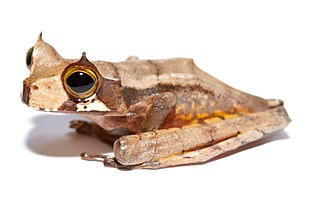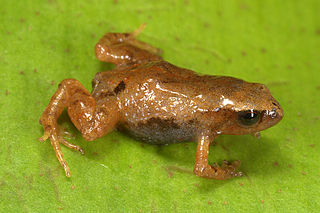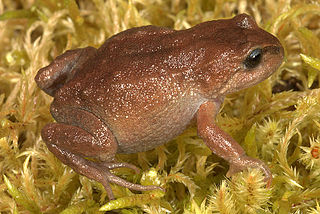
Telmatobius is a genus of frogs native to the Andean highlands in South America, where they are found in Ecuador, Peru, Bolivia, northwestern Argentina and northern Chile. It is the only genus in the family Telmatobiidae. Some sources recognize Batrachophrynus as a valid genus distinct from Telmatobius.

Gastrotheca is a genus of frogs in the family Hemiphractidae. They are found in Central America south of Costa Rica and in South America. Most species occur in the American Cordillera from southern Costa Rica to north-western Argentina. This genus makes up the bulk of marsupial frog diversity; formerly it was placed in the "Leptodactylidae" assemblage.

Phrynopus is a genus of frogs of the family Craugastoridae. Their common name is Andes frogs. They are endemic to Peru and inhabit the upper humid montane forest and supra-treeline grassland in the Cordillera Oriental, with one record from the Peruvian Cordillera Occidental.

Centrolene is a genus of glass frogs in the family Centrolenidae. The adult males are characterized by having a humeral spine, as most members of this family. The delimitation of this genus versus Cochranella is not fully resolved, and some species formerly in Centrolenella — which is nowadays synonymized with Centrolene — are now in Hyalinobatrachium.

Hyalinobatrachium is a genus of glass frogs, family Centrolenidae. They are widely distributed in the Americas, from tropical Mexico to southeastern Brazil and Argentina.

Oreobates is a frog genus of in the family Craugastoridae. Most species were formerly in the genus Ischnocnema, but were moved to this revalidated genus following a 2006 revision. Its sister taxon is Lynchius.

Hyloscirtus is a genus of Neotropical frogs in the family Hylidae. This genus was resurrected in 2005 following a major revision of the Hylidae, with the distinguishing features being 56 transformations in nuclear and mitochondrial proteins and ribosomal genes. Of these species, 28 species, previously placed in the genus Hyla, were moved to this genus. The fingers and toes of these frogs have wide dermal fringes.
Oreobates pereger is a species of frog in the family Craugastoridae. It is endemic to Peru where it is known from the eastern slopes of the Cordillera Oriental and Cordillera Vilcabamba mountain ranges.

Noblella peruviana is a species of frog in the family Strabomantidae. It is endemic to the Andean highlands in Peru.
Noblella lochites, also known as Ecuador leaf frog, is a species of frog in the family Strabomantidae. It is found on the Amazonian slopes of the Andes and Cordillera del Cóndor and the Cordillera de Cutucú in Ecuador and Peru; the Peruvian record has been disputed, although it is nevertheless expected that the species occurs in Peru.
Noblella myrmecoides is a species of frog in the family Strabomantidae. It is found in the upper Amazon Basin of southeastern Colombia, eastern Ecuador, eastern Peru, Bolivia, and western Brazil (Amazonas). Common name Loreto leaf frog has been coined for this species.

Nymphargus is a genus of glass frogs in the subfamily Centroleninae, which was established in 2007. They are distributed in the Andean slopes of Colombia, Ecuador, Peru, and Bolivia. They are characterized by lacking webbing among the outer fingers, lacking humeral spines in adult males, and having a lobed liver covered by a transparent hepatic peritoneum.

Pristimantis is a very large genus of frogs distributed in the southern Caribbean and in Central and South America from Honduras to northern Argentina and southern Brazil. With 570 described species, Pristimantis had more species than any other genus of vertebrate animals. Many of these species genus are endemic to the Northwestern Andean montane forests ecoregion in northwestern South America.

The Strabomantidae are a family of frogs native to South America. These frogs lack a free-living larval stage and hatch directly into miniature "froglets". This family includes Pristimantis, the most speciose genus of any vertebrate.

Bryophryne is a genus of frogs in the family Strabomantidae. These frogs are endemic to south-eastern Peru in the Cusco Region, with an undescribed species from the Puno Region. Their range is separated from that of Phrynopus by the Apurímac River valley.
Noblella duellmani is a species of frog in the family Strabomantidae. It is endemic to Peru and only known from its type locality, Cillapata, at 2,900 m (9,500 ft) asl in the Paucartambo District, Pasco Region.

Diasporus is a genus of frogs in the family Eleutherodactylidae. The genus was first described in 2008. They are found in Central and northern South America. They are sometimes referred to as dink frogs, in reference to the "tink" sound that males make during the mating season.

Lynchius is a small genus of frogs in the family Craugastoridae. The name honours herpetologist John D. Lynch. The distribution of Lynchius is restricted to the Cordillera Oriental in southern Ecuador and Cordillera de Huancabamba in northern Peru.

Psychrophrynella is a genus of frogs in the family Strabomantidae The genus is distributed on the Andes of southern Peru and Bolivia. One of the four species assessed by the International Union for Conservation of Nature (IUCN) is assessed as "Critically Endangered".

Niceforonia is a genus of frogs in the family Strabomantidae found in northern South America. The name refers to Nicéforo María, Colombian herpetologist.
















